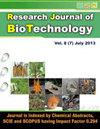Impact of feed on the yield of Litopenaeus vannamei and Macrobrachium rosenbergii prawn culture from West Godavari district, Andhra Pradesh, India
IF 0.2
Q4 Biochemistry, Genetics and Molecular Biology
引用次数: 0
Abstract
Aquaculture, a vital sector addressing global food demand, is characterized by its extensive water requirements. Categorized into mariculture, freshwater aquaculture, and brackish water aquaculture, the sector plays a crucial role in food production. This study focuses on prawn cultivation, a significant aspect of aquaculture, emphasizing the influence of feed quality and hydrographic parameters on yield and ecological sustainability. Conducted in Vissakoderu village (Litopenaeus vannamei) and Eduru village (Macrobrachium rosenbergii), the research employed commercial feed, optimizing physicochemical parameters such as temperature, pH, and salinity. Probiotics were integrated into the feed to enhance prawn growth. Results indicated optimal levels of moisture, lipids, protein, fiber, carbohydrates, minerals, and vitamins in the feed. The progressive weight gain of prawns, reaching 30.00 kg for 1000 prawns, was correlated with an increased feeding frequency. Scientifically monitored hydrographic conditions and feed quality contributed to a remarkable average yield of 29 tons for Litopenaeus vannamei and 63.33 tons for Macrobrachium rosenbergii over three years. This underscores the importance of precision in aquaculture practices for both yield enhancement and ecological preservation. The study provides valuable insights into the sensitivity of prawn cultivation, emphasizing the need for meticulous care in managing hydrographical, feed, and disease parameters.饲料对印度安得拉邦西戈达瓦里地区养殖的凡纳滨对虾和罗氏沼虾产量的影响
水产养殖是满足全球粮食需求的一个重要领域,其特点是需要大量用水。水产养殖分为海水养殖、淡水养殖和咸水养殖,在粮食生产中发挥着至关重要的作用。本研究的重点是对虾养殖,这是水产养殖的一个重要方面,强调饲料质量和水文参数对产量和生态可持续性的影响。研究在 Vissakoderu 村(南美白对虾)和 Eduru 村(罗氏沼虾)进行,采用商业饲料,优化温度、pH 值和盐度等理化参数。饲料中添加了益生菌,以促进对虾生长。结果表明,饲料中的水分、脂类、蛋白质、纤维、碳水化合物、矿物质和维生素达到了最佳水平。对虾的体重逐渐增加,1000 只对虾的增重达到 30.00 千克,这与投喂频率的增加有关。通过科学监测水文条件和饲料质量,三年来,凡纳滨对虾的平均产量达到 29 吨,大鳞对虾的平均产量达到 63.33 吨。这凸显了精确的水产养殖实践对提高产量和保护生态的重要性。这项研究为对虾养殖的敏感性提供了有价值的见解,强调了在管理水文、饲料和疾病参数时一丝不苟的必要性。
本文章由计算机程序翻译,如有差异,请以英文原文为准。
求助全文
约1分钟内获得全文
求助全文
来源期刊

Research Journal of Biotechnology
工程技术-生物工程与应用微生物
CiteScore
0.60
自引率
0.00%
发文量
192
审稿时长
1.5 months
期刊介绍:
We invite you to contribute Research Papers / Short Communications / Review Papers:
-In any field of Biotechnology, Biochemistry, Microbiology and Industrial Microbiology, Soil Technology, Agriculture Biotechnology.
-in any field related to Food Biotechnology, Nutrition Biotechnology, Genetic Engineering and Commercial Biotechnology.
-in any field of Biotechnology related to Drugs and Pharmaceutical products for human beings, animals and plants.
-in any field related to Environmental Biotechnolgy, Waste Treatment of Liquids, Soilds and Gases; Sustainability.
-in inter-realted field of Chemical Sciences, Biological Sciences, Environmental Sciences and Life Sciences.
-in any field related to Biotechnological Engineering, Industrial Biotechnology and Instrumentation.
-in any field related to Nano-technology.
-in any field related to Plant Biotechnology.
 求助内容:
求助内容: 应助结果提醒方式:
应助结果提醒方式:


